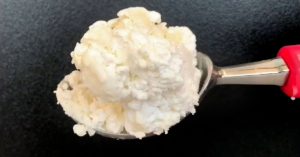
BY Chris Young
This newly-patented ‘instant ice cream’ is an impressive feat of physics and engineering that is also greener.
There’s always been a fine line between physics and magic; whether it’s demonstrations of the Bernoulli principle, Lichtenberg burning, or the Magnus Effect, masters of physics have often possessed the aura of a magician.
Two food scientists, Syed Rizvi, professor of food science engineering, and Michael E. Wagner, Ph.D. ’15, have just patented a clever use of the Joule-Thompson Effect that certainly has the potential to make the world a little more magical.
That’s because they created a machine that uses the effect to make instant ice cream at any time.
RELATED: WE CAN NOW ENGINEER COW-FREE ICE CREAM THAT TASTES SO GOOD
Never go without ice cream
Following a five-year application process, the U.S. Patent and Trademark Office has awarded a patent to Rizvi and Wagner for a process that uses pressurized carbon dioxide to turn a liquid ice cream mix into ice cream at any time.
It’s very simple, and this machine converts the mix into a scoop of ice cream in about three seconds,” Rizvi explained in a Cornell University press release. “The mix can be made commercially, locally or you can make it at home.”

While the traditional commercial method of making ice cream sees a dairy-based mix flow through a heat-exchanging barrel where it is gradually frozen, Rizvi and Wagner’s new method has highly pressurized carbon dioxide pass over a nozzle that creates a vacuum that draws in the liquid ice cream.
When the carbon dioxide goes from a high pressure to a lower pressure, it cools the ice cream mix to about minus 70 degrees C, flash-freezing it — via the aforementioned Joule-Thompson Effect — into ready-to-eat ice cream.
An additive-free environmentally friendly alternative
The real benefit to all of this? Aside from allowing anyone who owns a machine ice cream on-demand, instant ice cream removes the need for commercial transportation “cold chains,” in which the product has to be maintained at minus 20 degrees Celsius.
Throughout certain parts of the commercial ice cream cold-temperature delivery process, there might be failures that see the product defrost. In order to safeguard against this, commercial ice cream makers add stabilizers and emulsifiers.
With this in mind, Rizvi says, “consumers today want a clean product. They don’t want undesirable ingredients thrown into it.”
The application also goes beyond simply ice cream: “you can make a slushy out of soft drinks,” Rizvi continues. “You can convert water into carbonated ice instantly, too. Any liquid drink that can be partially frozen can be used.”
Ultimately, by doing away with the “cold chain” delivery process — and the additives — this ice cream looks like an attractive, practical, and tasty alternative to traditional ice cream making.